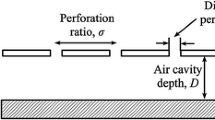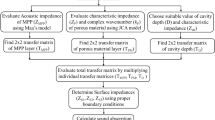Abstract
The micro-perforated panel (MPP) structure has been widely used in various noise control applications, and thus its acoustic performance prediction has been receiving increasing attention. The acoustic performance of simple MPP structures, such as a MPP sound absorber, has been predicted using an analytical calculation method. However, this is not a suitable approach toward predicting the acoustic performance of complicated MPP structures, owing to the structural complexity of these structures. Moreover, the many perforations of submillimeter scale diameter render the MPP structures very difficult to analyze using numerical simulation. Thus, this study focused on two different simplified MPP simulation methods: the transfer admittance method and the equivalent fluid method, and their application on double-layer MPP structures. Based on the two simplified MPP simulation methods, the transmission loss value of the double-layer MPP mufflers with two sets of different structural parameters was calculated, respectively. The predicted results were compared with the impedance tube measurements. The results revealed that the two simplified MPP simulation methods could effectively predict the acoustic performance of double-layer MPP structures. Moreover, the prediction based on the transfer admittance method can outperform the two simplified simulation methods.










Similar content being viewed by others
Abbreviations
- MPP:
-
Micro-perforated panel
- FEM:
-
Finite element method
- CFD:
-
Computational fluid dynamics
- t :
-
Panel thickness
- d :
-
Perforation diameter
- p :
-
Perforation ratio
- D 1, D 2 :
-
Cavity depth
- b :
-
Perforation spacing
- TL:
-
Transmission loss
- v n1, v n2 :
-
Normal particle velocity
- α 1, α 2, α 3, α 4, α 5, α 6 :
-
Transfer admittance coefficient
- p 1, p 2 :
-
Sound pressure
- β :
-
Transfer admittance
- K :
-
Diameter ratio
- Z :
-
Specific acoustic impedance
- R :
-
Specific acoustic resistance
- X :
-
Specific acoustic reactance
- η :
-
Dynamic viscosity
- ρ :
-
Air density
- ω :
-
Angular frequency
- f :
-
Frequency
- φ :
-
Porosity
- σ :
-
Flow resistivity
- α ∞ :
-
Tortuosity
- ε e :
-
Correction length
- A v :
-
Viscous characteristic length
- A t :
-
Thermal characteristic length
References
Maa, D.Y.: Theory and design of micro-perforated panel sound absorbing constructions. Sci. Sin 18, 55–71 (1975)
Yairi, M., Sakagami, K., Takebayashi, K., et al.: Excess sound absorption at normal incidence by two microperforated panel absorbers with different impedance. Acoust. Sci. Tech. 32(5), 194–200 (2011)
Qian, Y.J., Cui, K., Liu, S.M., et al.: Optimization of multi-size micro-perforated panel absorbers using multi-population genetic algorithm. Noise Control Eng. J. 62(1), 37–46 (2014)
Qian, Y.J., Zhang, J., Sun, N., et al.: Pilot study on wideband sound absorber obtained by adopting a serial-parallel coupling manner. Appl. Acoust. 124, 48–51 (2017)
Liu, Z., Zhan, J., Fard, M., et al.: Acoustic measurement of a 3D printed micro-perforated panel combined with a porous material. Measurement 104, 233–236 (2017)
Liu, Z., Zhan, J., Fard, M., et al.: Acoustic properties of multilayer sound absorbers with a 3D printed micro-perforated panel. Appl. Acoust. 121, 25–32 (2017)
Bravo, T., Maury, C., Pinhède, C.: Enhancing sound absorption and transmission through flexible multi-layer micro-perforated structures. J. Acoust. Soc. Am. 134(5), 3663–3673 (2013)
Zhao, X.D., Yu, Y.J., Wu, Y.J.: Improving low-frequency sound absorption of micro-perforated panel absorbers by using mechanical impedance plate combined with Helmholtz resonators. Appl. Acoust. 114, 92–98 (2016)
Gerdes, R., Alexander, J., Herdtle, T.: Acoustic performance prediction of micro-perforated panel using computational fluid dynamics and finite element analysis. SAE Technical Paper, 2013-01-2000
Zuo, S.G., Zhang, J., Wu, X.D., et al.: The optimization of micro-perforated tube muffler used for noise elimination of fuel cell vehicle. Manuf. Autom. 36(9), 107–111 (2014). (in Chinese)
Atalla, N., Sgard, F.: Modeling of perforated plates and screens using rigid frame porous models. J. Sound Vib. 303(1), 195–208 (2007)
Hou, K.: Measurement and modeling of micro-perforated panels.. Purdue University, West Lafayette (2009)
Bolton, J.S., Hou, K.: Finite element models of micro-perforated panels. INTER-NOISE and NOISE-CON Congress and Conference Proceedings, InterNoise09, Ottawa CANADA, pp. 2420–2428 (2009)
Maa, D.Y.: Microperforated-panel wideband absorber. Noise Control Eng. J. 29(3), 77–84 (1987)
Sakagami, K., Yairi, M., Morimoto, M.: Multiple-leaf sound absorbers with microperforated panels: an overview. Acoust. Aust. 38, 76–81 (2010)
Bravo, T., Maury, C., Pinhede, C.: Enhancing sound absorption and transmission through flexible multi-layer micro-perforated structures. J. Acoust. Soc. Am. 134(5), 3663–3673 (2013)
Xiang, L.Y., Zuo, S.G., Wu, X.D., et al.: Study of multi-chamber micro-perforated muffler with adjustable transmission loss. Appl. Acoust. 122, 35–40 (2017)
Allam, S., Guo, Y., Abom, M.: Acoustical study of micro- perforated plates for vehicle applications. SAE Technical Paper, 2009-01-2037
Yu, X., Cheng, L., You, X.Y.: Hybrid silencers with micro-perforated panels and internal partitions. J. Acoust. Soc. Am. 137(2), 951–962 (2015)
Zhan, F.L., Xu, J.W.: Virtual Lab Acoustics: Mastering the Acoustics Simulation Computation. Northwestern Polytechnic University Press, Xi’an (2013). (in Chinese)
Kidner, M.R.F., Hansen, C.H.: A Comparison and Review of Theories of the Acoustics of Porous Materials. The University of Adelaide, South Australia (2008)
Xiang, L.Y., Zuo, S.G., Wu, X.D., et al.: Acoustic behaviour analysis and optimal design of a multi-chamber reactive muffler. In: Proceedings of the IMechE, Part D: Journal of Automobile Engineering, pp. 1–9 (2016)
Hua, X., Zhang, Y., Herrin, D.W.: The effect of conical adapters and choice of reference microphone when using the two-load method for measuring muffler transmission loss. Appl. Acoust. 93, 75–87 (2015)
Acknowledgements
This study was supported by the National Key Laboratory Open Foundation of Tractor Power System (Grant No. SKT2017012) and the National Natural Science Foundation of China (Grant No. 51575410).
Author information
Authors and Affiliations
Corresponding author
Rights and permissions
About this article
Cite this article
Chen, W., Lu, C., Liu, Z. et al. Simplified Method of Simulating Double-Layer Micro-Perforated Panel Structure. Automot. Innov. 1, 374–380 (2018). https://doi.org/10.1007/s42154-018-0040-x
Received:
Accepted:
Published:
Issue Date:
DOI: https://doi.org/10.1007/s42154-018-0040-x




